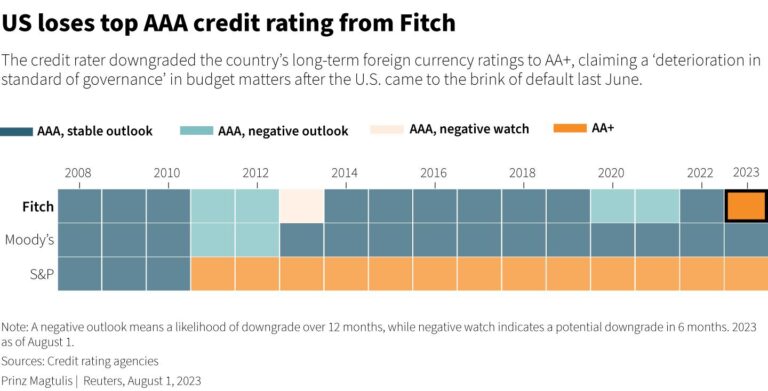MoodyŌĆÖs Downgrades U.S. Credit Rating Amid Escalating Fiscal Pressures
MoodyŌĆÖs Lowers U.S. Sovereign Rating, Citing Persistent Fiscal Vulnerabilities
MoodyŌĆÖs Investors Service has recently downgraded the United StatesŌĆÖ sovereign credit rating, reflecting growing concerns over the nationŌĆÖs fiscal trajectory. The agency emphasized the widening budget deficits and the lack of effective, long-term fiscal reforms as primary drivers behind this decision. This downgrade signals potential increases in government borrowing costs and a decline in international confidence regarding the U.S. economyŌĆÖs durability.
Several pivotal elements influenced MoodyŌĆÖs assessment:
- Rapid expansion of federal spending without proportional revenue growth
- Tax legislation during the Trump administration that significantly reduced government income
- Ongoing political gridlock obstructing comprehensive debt reduction strategies
| Fiscal Element | Impact | Projected Trend |
|---|---|---|
| Tax Cuts | Revenue Decline | Adverse |
| Deficit Growth | Increasing National Debt | Worsening |
| Political Deadlock | Policy Uncertainty | Unstable |
Consequences of Trump-Era Tax Cuts on Deficit Expansion and Debt Accumulation
MoodyŌĆÖs report directly associates the surge in the U.S. budget deficit with the comprehensive tax cuts implemented during the Trump administration. These reforms, which predominantly favored corporations and high-income earners, have sharply diminished federal revenue without equivalent reductions in government expenditures. As a result, the national debt has accelerated, raising serious questions about the countryŌĆÖs fiscal sustainability and creditworthiness over the long term.
Highlighted concerns include:
- Expanding fiscal deficits: Projected to grow substantially in the coming decade.
- Rising interest payments: Increasing strain on the federal budget as debt levels climb.
- Risk of further credit downgrades: If fiscal discipline is not reinstated.
To illustrate these trends, MoodyŌĆÖs provided comparative projections of federal budget indicators:
| Year | Deficit (Trillions USD) | Debt-to-GDP Ratio (%) |
|---|---|---|
| 2017 | 0.66 | 77 |
| 2022 | 1.10 | 98 |
| 2027 (Projected) | 1.50 | 112 |
Financial Market Response: Increased Volatility and Cautious Investment Behavior
The credit rating downgrade has sent ripples through global financial markets, prompting heightened investor caution. Concerns over the ballooning federal debt, intensified by aggressive tax cuts, have led to greater market instability and a preference for safer assets. This shift underscores skepticism about the governmentŌĆÖs ability to uphold long-term economic stability.
Experts identify several economic repercussions linked to the downgrade:
- Higher borrowing costs: Increased interest rates on U.S. debt may limit fiscal maneuverability.
- Shift toward safe-haven assets: Investors are likely to reduce equity holdings in favor of government securities.
- Currency fluctuations: The U.S. dollar may experience volatility, affecting international trade and capital flows.
- Uncertainty in credit markets: Both public and private sectors could face challenges in accessing financing.
| Sector | Short-Term Effect | Long-Term Concern |
|---|---|---|
| Federal Debt | Rising yields | Questions about fiscal viability |
| Stock Markets | Heightened volatility | Reduced investor confidence |
| Foreign Investment | Potential capital withdrawal | Weakened dollar dominance |
Policy Recommendations: Balancing Tax Relief with Fiscal Responsibility
Economists and fiscal policy experts advocate for a measured approach that harmonizes tax reductions with responsible budget management. The swift implementation of broad tax cuts has intensified concerns about the growing national debt and its destabilizing impact on financial markets. To address these challenges, experts suggest:
- Targeted cuts in discretionary spending to eliminate wasteful expenditures
- Boosting revenues through growth-oriented policies that expand the tax base
- Implementing sustainable fiscal frameworks to safeguard long-term economic stability
Recent fiscal data before and after the tax reforms, along with future projections, underscore these shifts:
| Indicator | Pre-Tax Cuts (2016) | Post-Tax Cuts (2018) | Forecast (2024) |
|---|---|---|---|
| Federal Deficit (% of GDP) | 3.2% | 4.7% | 5.1% |
| Debt-to-GDP Ratio | 77% | 85% | 95% |
| MoodyŌĆÖs Credit Rating | Aa2 | Aa3 (Downgraded) | Aa3 or Lower (Projected) |
These statistics highlight the urgent need for integrated fiscal policies that maintain economic credibility while supporting growth objectives.
Future Outlook: Addressing Fiscal Challenges to Rebuild Confidence
The recent downgrade of the U.S. credit rating by MoodyŌĆÖs underscores the intensifying fiscal challenges confronting the nation amid ambitious tax reforms. As policymakers continue to pursue growth-driven tax strategies, the necessity to balance these efforts with disciplined fiscal management becomes paramount. Moving forward, restoring investor confidence and ensuring financial stability will require forward-thinking economic policies and a commitment to sustainable budgeting.




